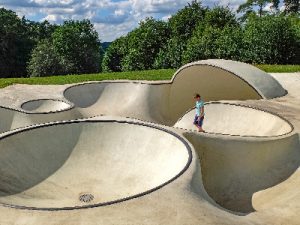We’ve all felt the thrill of longboarding in a well-designed mini park. But what if you could experience that adrenaline rush right in your backyard? Here’s our guide to building your own mini park at home! So, prepare your longboard now! We understand that it might seem like a daunting task, but we’re here to assure you it’s not only possible but also incredibly rewarding.

Longboarding is a great way to stay active, practice coordination, and build community. With careful planning, materials like steel coping and treated lumber, and a dash of elbow grease, you can build a personal skating ground for yourself or your community.
This comprehensive guide will walk you through everything from understanding action sports park design basics, such as incorporating flat bottom and transition sections, to ensuring proper safety measures, including helmets, pads, and protective gear. So strap on your helmets and get ready to dive into an exciting DIY project with riders of all ages thanking you!
Key Takeaways
- Plan the layout and design of the skatepark, considering location, budget, and materials.
- Gather materials cost-effectively and with eco-friendly strategies.
- Construct the skateparks in stages, focusing on safety, aesthetics, and durability.
- Safety measures are crucial – always wear protective gear like helmets, elbow pads, and knee guards.
- Regular maintenance and weatherproofing ensure the longevity and performance of your skatepark.
Enjoy the thrill of skateboarding with friends and family, creating lasting memories in your small skatepark.
Planning Out The Layout
Planning out the layout and design is essential before diving headfirst into constructing your action sports park. Visualize where each ramp, rail, or half-pipe will go in your chosen space. Utilizing a circular saw for precision cuts in the construction process is crucial.
At FamilyHype, we understand the importance of planning and ensuring you consider all factors, such as the action ramp location, budget, and quality of materials, like flat sections and transition sections of your parks. A clear plan paves the way to understanding the basics of action sports park design next.
Longboard riders can benefit from a well-designed action sports park, which includes safety rails, ramps, banks, a quarter-pipe, a half-pipe, and ledges made from treated lumber. We must consider the location carefully – is there enough room? What about budget considerations for the circular saw and other tools? Can we afford quality materials like steel coping for durability?
Considering the purpose and overall design before starting the project is important, especially when incorporating flat bottom and transition sections. We must also remember the overall focus of this article is about boards, so make a connection between them and the article title.
Sharing feedback about the content, their experience, or opinions is also important. Therefore, FamilyHype encourages readers to share their thoughts and opinions on this topic and the use of tools like a circular saw.
Mini Sports Plaza Design
To truly appreciate the art of action sports park design, you’ve got to grasp a few fundamental principles. Aesthetics are vital – they add beauty and inspire creativity. By understanding what makes parks visually appealing, such as incorporating a flat section and a transition section, we can take that design inspiration and apply it to our small parks.

With these insights, we’re ready to move onto an exciting new phase: gathering materials like a thinner layer of plywood and a top layer for our home action sports park project. At FamilyHype, we believe that longboarding is a great way to bring families together, and these small ramp design principles are a great place to start!
Don’t forget the overall focus of this article is on longboards and action sports park design, incorporating elements like flat bottoms and the sections of the two transitions. FamilyHype strives to provide helpful content for parents and longboard riders of all ages, whether using a jigsaw or a circular saw.
Gather Materials
At FamilyHype, we’re passionate about empowering families to explore their creative side and build something unique. That’s why we’re so excited to help you with this action sports park project! Now’s the time to roll up your sleeves and get prepared – it’s time to gather materials like two sheets of plywood, including thinner plywood, paint, drill bit, wood screws, nails, and other materials for the construction.
Let’s explore some material sourcing strategies that aren’t only cost-effective but also eco-friendly, such as using treated lumber. This approach reflects our commitment to serve others by creating a fun, safe space while respecting Mother Earth.
Ready? Now that you’ve gathered the materials let’s look at how to bring them all together and begin constructing your action sports park using tools like a jigsaw for precise cuts!
Constructing Your Mini Sports Plaza
Having gathered all the essential materials, it’s high time we transformed them into a thrilling and safe space for longboards. At FamilyHype, we know how important it is to have a safe and enjoyable experience.
Let’s focus on:
- Aesthetics: Your mini skatepark should reflect your style.
- Cost: Keep a check on your budget for a mini skatepark.
- Stages: Start small and expand your skatepark over time.
- Skate Materials: Durable materials to use in a skatepark ensure longevity.
- Elements: Skatepark ramps, rails, grind boxes, quarter pipes, etc.
When constructing a quarter pipe, start by laying the framing. Make sure it’s feet tall for sufficient height. Drill holes through the framing to attach the deck. On the deck, add a small notch at each end. Then, lay the concrete pad as a sturdy base. For the small ramp surface, lay long pieces of wood and repeat the process until reaching the top edge. Ensure each board is feet high, and use a smaller hole drill bit to avoid water damage.
Next up, we’ll discuss how to keep safety at the forefront. As longboards are the focus of this article, we must consider the various safety measures needed to create a secure action sports park.
From ensuring the correct materials are used to making sure the small ramps and rails are of the right size and shape, safety should be the top priority. Add a final layer of sealant to protect against elements, and push or slide the small ramp into place, aligning the holes with the same amount of space on each side.
Safety Measures
Let’s delve into the crucial aspect of safety measures, ensuring a thrilling yet secure longboards experience for you and your loved ones. Injury prevention is key; we can’t stress enough the importance of donning protective gear such as helmets, elbow pads, and knee guards. These are not optional and should be part of your skating routine to ensure a safe experience.

At FamilyHype, we highly value the family unit and want to ensure everyone has a safe, enjoyable time at the parks. We understand that constructing and maintaining an action sports park can be a family project, and safety must be the first layer in this exciting endeavor.
Remember, a safe park equals more fun! Now that we’ve got safety covered let’s move to keep your action sports park in tip-top shape.
Maintenance
Maintaining an action sports park in prime condition ensures your longboard rides smoothly and lasts for years. Here at FamilyHype, we understand how important it is to keep your action sports park free of debris and other hazards, so we encourage regular cleaning routines to prepare the second layer of safety.

- Pre-drill your action sports park to prevent any structural issues and ensure the small ramps are securely fixed in the same place. By weatherproofing the action sports park, you can protect it against the elements and extend its life. Skateboarding is fun and an investment; proper maintenance ensures you get the most out of it.
- As we focus on skateboards in this article, it’s important to remember that proper maintenance of the action sports park is essential for the longevity and performance of your skateboard. A well-maintained action sports park is like having two layers of protection for your skateboard, enhancing its performance and safety.
We hope this article provides the guidance you need to keep your action sports park in shape.
Conclusion
We’ve finally arrived! After planning, designing, and building a DIY small ramp, it’s time to let the fun begin. Remember, safety is paramount when constructing and using a small ramp. Following established plans is recommended, such as using proper safety equipment while making and skating and ensuring the small ramp is structurally sound before use.
With longboarding, there are many different styles and sizes of longboards to choose from, each offering its unique benefits and challenges.
No matter the size of the action sports park you choose to build, safety is paramount, and regular maintenance is essential for longevity. Two layers of safety, first by using protective gear and second by proper maintenance, will ensure a secure and enjoyable ride and experience for all.
With your mini ramp, you can enjoy the thrill of longboarding with friends and family while creating lasting memories. So, don’t forget your helmet, pads, and other protective gear, and get ready to hit the entire ramp.
Ride on!
FAQs
How Much Does A Tiny Halfpipe Cost?
The cost of building a mini halfpipe can vary depending on factors like size, materials used, and labor. Generally, materials such as pressure-treated wood, sheets of plywood, black steel pipe, and mini ramp armor contribute to the cost. The tools required to construct parks and professional assistance could also impact the total cost.
How Do You Build A Mini Skate Ramp?
To build a mini ramp, follow these basic steps:
- Measure and cut the wood to make two decks, each with a notch at one end
- Attach the decks with screws, making sure the notches line up
- Drill a hole at each corner of the decks and insert a screw through the hole. This will be the point where you will attach the legs of the skatepark.
- Cut four boards to make the legs and screw them to the decks
- Add some edge guards to the sides of the decks to make them safer
- Enjoy your small skatepark by standing on it and riding your skateboard
What Is The Best Material For Making Ramp?
Pressure-treated wood is commonly used for the frame and supports of a mini ramp due to its durability and resistance to outdoor elements. Plywood is the preferred choice for the riding surface due to its smoothness and suitability for longboarding.
How Small Can You Make A Mini Ramp?
There isn’t a strict size requirement for a mini ramp, but they typically start around 3 feet in height and can vary in width and length. Maintaining safe dimensions that allow for comfortable skating and tricks is important.
What Plywood Is Used For Ramps?
A standard piece of plywood with a smooth surface is commonly used for ramp construction. Make sure to select the sheet of plywood that is suitable for outdoor use and has a thick plywood appropriate for the intended use of the ramp.
How To Make An Indoor Ramp?
Building an indoor new mini ramp is similar to an outdoor ramp. However, you may want to consider additional ventilation or climate control measures since indoor ramps are not exposed to natural weather conditions.
Is It Hard To Make Halfpipe?
Building a halfpipe requires basic carpentry skills and tools. While it may seem challenging, following detailed plans and instructions can make the process manageable for individuals with some DIY experience.
How Many Sheets Of Plywood Do I Need For Skate Ramp?
The number of plywood sheets needed for a mini ramp depends on the size and design of the ramp. Typically, you’ll need several sheets and layers of plywood for the riding surface and additional sheets for the structure and supports.
Are Aluminum Ramps Slippery?
Aluminum ramps can be slippery, especially when wet. Adding grip tape or a non-slip surface to the riding area can help improve traction and safety.
What Are Ideal Mini Ramp Dimensions?
Ideal mini ramp dimensions can vary based on personal preference, but a common range might be around 3-4 feet in height, 8-12 feet in width, and 20-24 feet in length. Adjusting these dimensions can accommodate different skill levels and available space.
Last Updated on June 5, 2024 by Allen Laconsay
DISCLAIMER (IMPORTANT): This information (including all text, images, audio, or other formats on FamilyHype.com) is not intended to be a substitute for informed professional advice, diagnosis, endorsement or treatment. You should not take any action or avoid taking action without consulting a qualified professional. Always seek the advice of your physician or other qualified health provider with any questions about medical conditions. Do not disregard professional medical advice or delay seeking advice or treatment because of something you have read here a FamilyHype.com.